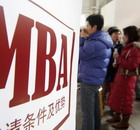BizViews
It takes homework to find best company leaders
(China Daily)
Updated: 2009-12-14 08:01

Editor's Note: The sharp downturn in the world economy places the challenge of developing corporate leadership in a new perspective. Leadership becomes more urgent than ever in a downturn, and ensuring an adequate supply of leaders in the roles where they can make the most difference remains a priority.
Vikki Tam, a partner at Bain & Co in the company's Shanghai office, leads the organization practice for Greater China, and she has developed extensive knowledge about developing leadership talents.
As the Chinese economy rebounds from the global downturn ahead of other countries, job seekers from around the world are crowding Chinese job fairs.
Prospective Chinese employers are inundated with applications for jobs across all industries and positions, many from natives who have been laid off abroad. After years of a skilled talent shortage, employers are enjoying rich pickings among the best and brightest.
But this surge in applicants cannot change a nagging reality: As the economy once again heats up, employers will face an increasing talent crunch, especially for business leaders.
Even now, senior managers who are familiar with China and risk management, as well as speak Chinese and English, are in short supply. For companies to make the most of opportunities during the economy recovery, they must have an adequate supply of leaders in the right jobs.
Our work in China and across the world shows that three specific steps not only have an immediate impact on talent supply, but also lay the foundation for a sustainable, longer-term supply of leaders.
The first is to quantify the leadership gap. Many companies don't have a detailed picture of their talent challenge.
A rigorous analytic picture of the talent gap makes the challenge visible. The second step is to deploy existing talent more effectively.
Many companies don't know who their top performers are. Nor have they placed them in jobs where they can have the most impact.
A third step, often overlooked, is to reduce the demand for talent. Organizations that simplify their processes and spell out accountabilities can simultaneously control costs and make the most of existing talent.
Taken together, these steps help leaders address their talent challenges quickly. They also build a longer-term commitment throughout the organization, which is required to sustain an investment in leadership supply.
Assessing talent
Understanding the leadership gap - namely the difference between demand for talent and likely supply - is best accomplished through meticulous analysis of the current situation and a careful forecast of future changes.
|
||||
The demand side begins with a similarly fundamental analysis. What will the business look like in a year, or five years? How many leaders will you need in each unit, and what skills will they need?
During a recovery, some business units and regions will grow. But others will still be flat, and may export talent to talent-starved parts of the business. Matching the supply forecast to the demand forecast shows where the talent needs are likely to be most acute.
Next, make the most of available talent. Many CEOs admit that most mission-critical roles are filled by average or poor performers instead of top performers.
A 2008 Bain & Co survey of 760 companies across six geographic regions found that less than 25 percent of respondents strongly agree that "our best people are in the jobs where they add most value". Matching top performers with key roles typically involves three moves.
The first step is to identify the positions themselves. What jobs make the biggest difference to business performance, depending on the caliber of the person occupying them? In which roles will a top performer have more impact than an average performer?











